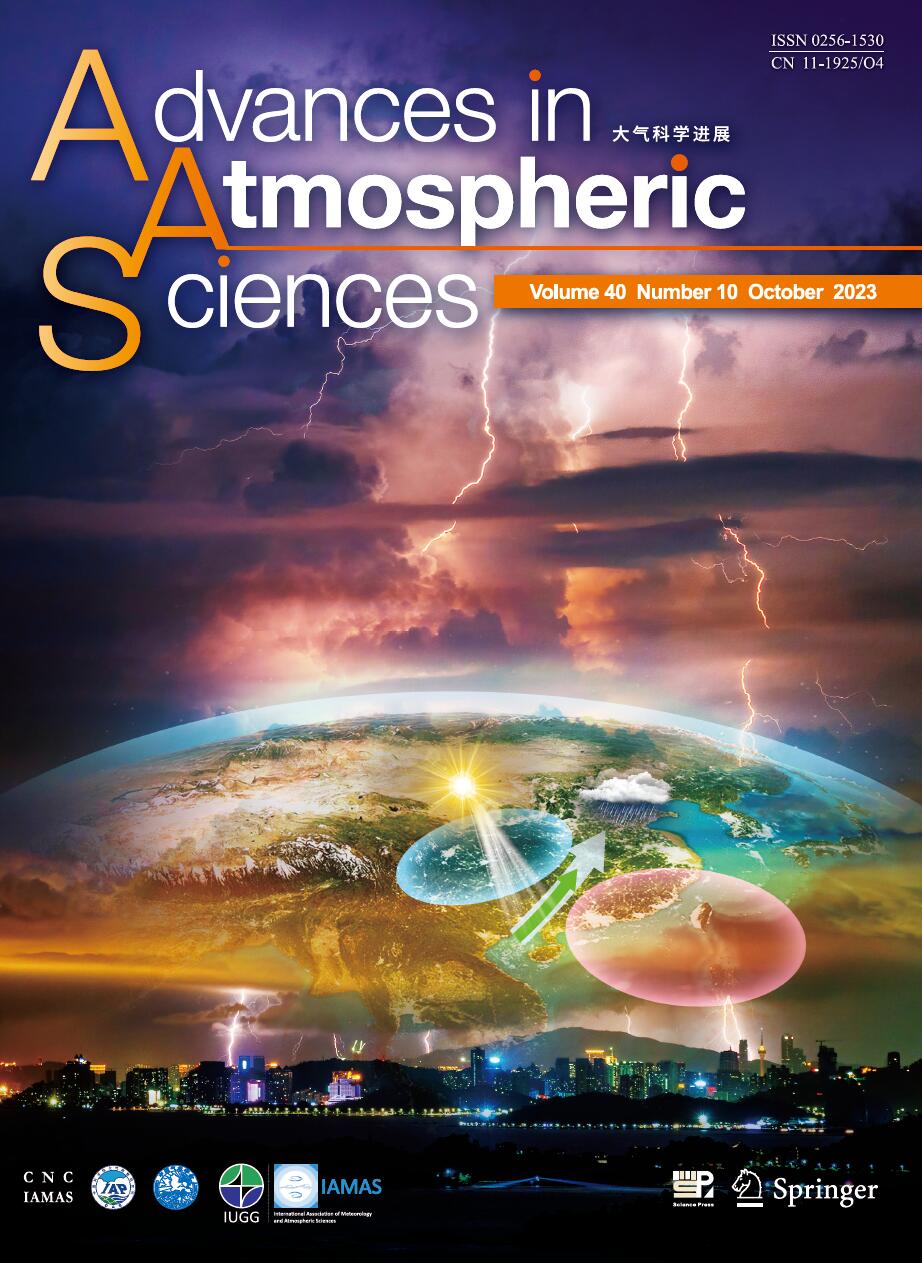| [1] |
Li Yinpeng, Ji Jinjun,
2001: Model Estimates of Global Carbon Flux between Vegetation and the Atmosphere, ADVANCES IN ATMOSPHERIC SCIENCES, 18, 807-818.
|
| [2] |
WANG Xiaocong, LIU Yimin, WU Guoxiong, Shian-Jiann LIN, BAO Qing,
2013: The Application of Flux-Form Semi-Lagrangian Transport Scheme in a Spectral Atmosphere Model, ADVANCES IN ATMOSPHERIC SCIENCES, 30, 89-100.
doi: 10.1007/s00376-012-2039-2
|
| [3] |
Jie SUN, Michael SECOR, Ming CAI, Xiaoming HU,
2024: A Quasi-Linear Relationship between Planetary Outgoing Longwave Radiation and Surface Temperature in a Radiative-Convective-Transportive Climate Model of a Gray Atmosphere, ADVANCES IN ATMOSPHERIC SCIENCES, 41, 8-18.
doi: 10.1007/s00376-023-2386-1
|
| [4] |
Yang Jingmei, Qiu Jinhuan,
1992: An Easy Algorithm for Solving Radiative Transfer Equation in Clear Atmosphere, ADVANCES IN ATMOSPHERIC SCIENCES, 9, 483-490.
doi: 10.1007/BF02677081
|
| [5] |
Qiu Jinhuan,
1989: Theoretical Analysis of Retrieving Atmospheric Columnar Mie Optical Depth from Downward Total Solar Radiative Flux, ADVANCES IN ATMOSPHERIC SCIENCES, 6, 313-324.
doi: 10.1007/BF02661537
|
| [6] |
DAI Qiudan, SUN Shufen,
2006: A Generalized Layered Radiative Transfer Model in the Vegetation Canopy, ADVANCES IN ATMOSPHERIC SCIENCES, 23, 243-257.
doi: 10.1007/s00376-006-0243-7
|
| [7] |
DAI Qiudan, SUN Shufen,
2007: A Simplified Scheme of the Generalized Layered Radiative Transfer Model, ADVANCES IN ATMOSPHERIC SCIENCES, 24, 213-226.
doi: 10.1007/s00376-007-0213-8
|
| [8] |
Ye Zhuojia, Li Jun, Fan Sihong,
1997: Turbulent Fluxes over Inhomogeneous Landscape, ADVANCES IN ATMOSPHERIC SCIENCES, 14, 399-408.
doi: 10.1007/s00376-997-0059-0
|
| [9] |
ZHENG Xunhua, LIU Chunyan, HAN Shenghui,
2008: Description and Application of a Model for Simulating Regional Nitrogen Cycling and Calculating Nitrogen Flux, ADVANCES IN ATMOSPHERIC SCIENCES, 25, 181-201.
doi: 10.1007/s00376-008-0181-7
|
| [10] |
DUAN Minzheng, Qilong MIN, LU Daren,
2010: A Polarized Radiative Transfer Model Based on Successive Order of Scattering, ADVANCES IN ATMOSPHERIC SCIENCES, 27, 891-900.
doi: 10.1007/s00376-009-9049-8
|
| [11] |
Yaqi WANG, Zipeng YU, Pengfei LIN, Hailong LIU, Jiangbo JIN, Lijuan LI, Yanli TANG, Li DONG, Kangjun CHEN, Yiwen LI, Qian YANG, Mengrong DING, Yao MENG, Bowen ZHAO, Jilin WEI, Jinfeng MA, Zhikuo SUN,
2020: FGOALS-g3 Model Datasets for CMIP6 Flux-Anomaly-Forced Model Intercomparison Project, ADVANCES IN ATMOSPHERIC SCIENCES, 37, 1093-1101.
doi: 10.1007/s00376-020-2045-8
|
| [12] |
Jiangbo JIN, Xiao DONG, Juanxiong HE, Yi YU, Hailong LIU, Minghua ZHANG, Qingcun ZENG, He ZHANG, Xin GAO, Guangqing ZHOU, Yaqi WANG,
2022: Ocean Response to a Climate Change Heat-Flux Perturbation in an Ocean Model and Its Corresponding Coupled Model, ADVANCES IN ATMOSPHERIC SCIENCES, 39, 55-66.
doi: 10.1007/s00376-021-1167-y
|
| [13] |
HUANG Feng, LIU Shikuo,
2004: Physical Mechanism and Model of Turbulent Cascades in a Barotropic Atmosphere, ADVANCES IN ATMOSPHERIC SCIENCES, 21, 34-40.
doi: 10.1007/BF02915678
|
| [14] |
Chengyan LIU, Zhaomin WANG, Bingrui LI, Chen CHENG, Ruibin XIA,
2017: On the Response of Subduction in the South Pacific to an Intensification of Westerlies and Heat Flux in an Eddy Permitting Ocean Model, ADVANCES IN ATMOSPHERIC SCIENCES, 34, 521-531.
doi: 10.1007/s00376-016-6021-2
|
| [15] |
KANG Xianbiao, HUANG Ronghui, WANG Zhanggui, ZHANG Rong-Hua,
2014: Sensitivity of ENSO Variability to Pacific Freshwater Flux Adjustment in the Community Earth System Model, ADVANCES IN ATMOSPHERIC SCIENCES, 31, 1009-1021.
doi: 10.1007/s00376-014-3232-2
|
| [16] |
Huang Meiyuan, Hong Yanchao,
1984: INHOMOGENEOUS FEATURES IN ME1-YU FRONTAL CLOUD SYSTEM, ADVANCES IN ATMOSPHERIC SCIENCES, 1, 95-111.
doi: 10.1007/BF03187620
|
| [17] |
Jiangbo JIN, He ZHANG, Xiao DONG, Hailong LIU, Minghua ZHANG, Xin GAO, Juanxiong HE, Zhaoyang CHAI, Qingcun ZENG, Guangqing ZHOU, Zhaohui LIN, Yi YU, Pengfei LIN, Ruxu LIAN, Yongqiang YU, Mirong SONG, Dongling ZHANG,
2021: CAS-ESM2.0 Model Datasets for the CMIP6 Flux-Anomaly-Forced Model Intercomparison Project (FAFMIP), ADVANCES IN ATMOSPHERIC SCIENCES, 38, 296-306.
doi: 10.1007/s00376-020-0188-2
|
| [18] |
LI Jiandong, Zhian SUN, LIU Yimin, Jiangnan LI, Wei-Chyung WANG, WU Guoxiong,
2012: A Study on Sulfate Optical Properties and Direct Radiative Forcing Using LASG-IAP General Circulation Model, ADVANCES IN ATMOSPHERIC SCIENCES, 29, 1185-1199.
doi: 10.1007/s00376-012-1257-y
|
| [19] |
Sun-Hee SHIN, Ok-Yeon KIM, Dongmin KIM, Myong-In LEE,
2017: Cloud Radiative Effects and Changes Simulated by the Coupled Model Intercomparison Project Phase 5 Models, ADVANCES IN ATMOSPHERIC SCIENCES, 34, 859-876.
doi: 10.1007/s00376-017-6089-3
|
| [20] |
Mingyue SU, Chao LIU, Di DI, Tianhao LE, Yujia SUN, Jun LI, Feng LU, Peng ZHANG, Byung-Ju SOHN,
2023: A Multi-Domain Compression Radiative Transfer Model for the Fengyun-4 Geosynchronous Interferometric Infrared Sounder (GIIRS), ADVANCES IN ATMOSPHERIC SCIENCES, 40, 1844-1858.
doi: 10.1007/s00376-023-2293-5
|















 AAS Website
AAS Website 
 AAS WeChat
AAS WeChat 
 DownLoad:
DownLoad: